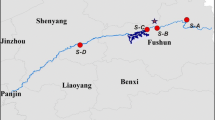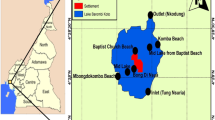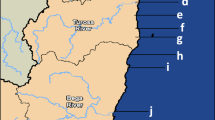Abstract
The three-ridge clamAmblema perplicata was used to monitor two streams for the presence of zinc (Zn) and cadmium (Cd) derived from an industrial source. Clams were collected from a relatively uncontaminated area in one river and transported to four study sites in the two contaminated streams. The clams were placed into polyethylene cages and left in these streams for one week. Control clams were treated in a similar manner and left in the uncontaminated river.
The highest mean concentration of Zn (956 µg/g dry wt) was found in the gill tissue of clams from the most contaminated site. The highest mean Cd concentration (18.6 µg/ g dry wt) was found in digestive glands of clams, also from the most contaminated site. Mean concentrations at contaminated sites were significantly higher than background and control levels; the findings suggest that these particular organs of clams may be useful in monitoring levels of Zn and Cd in other freshwater systems.
Similar content being viewed by others
References
Adams, T. G., Atchison, G. J., & Vetter, R. J., 1980. The impact of an industrially contaminated lake on heavy metal levels in its effluent stream. Hydrobiologia 69: 187–193.
Anderson, R. V., 1977. Concentration of cadmium, copper, lead, and zinc in six species of freshwater clams. Bull. Environ. Contam. Toxicol. 18: 492–496.
Atchison, G. J., Murphy, B. R., Bishop, W. E., McIntosh, A. W. & Mayes, R. A., 1977. Trace metal contamination of bluegill (Lepomis macrochirus) from two Indiana lakes. Trans. Am. Fish. Soc. 106: 637–640.
Bedford, J. W., Roelofs, E. W. & Zabik, M. J., 1968. The freshwater mussel as a biological monitor of pesticide concentrations in a lotic environment. Limnol. Oceanog. 13: 118–126.
Boyden, C. R., 1974. Trace element content and body size in molluscs. Nature 251: 311–314.
Bryan, G. W., 1976. Some aspects of heavy metal contamination in aquatic organisms. pp. 7–34. In A. P. Lockwood [Ed.]. Effects of pollutants on aquatic organisms. Society for Experimental Biology Seminar, Series Z. Cambridge Univ. Press.
Butler, P. A., 1973. Organochlorine residues in estuarine molluscs, 1965–1972-National Pesticide Monitoring Program. Pestic. Monit. J. 6: 238–362.
Coughtrey, P. J. & Martin, M. H., 1976. The distribution of Pb, Zn, Cd and Cu within the pulmonate molluscHelix aspersa Muller. Oecologia 23: 315–322.
Darracott, A. & Watling, H., 1975. The use of molluscs to monitor cadmium levels in estuaries and coastal marine environments. Trans. Roy. Soc. S. Afr. 41: 325–338.
Enk, M. D. & Mathis, B. J., 1977. Distribution of cadmium and lead in a stream ecosystem. Hydrobiologia 52: 153–158.
Foster, R. B. & Bates, J. M., 1978. Use of freshwater mussels to monitor point source industrial discharges. Environ. Sci. Technol. 12: 958–962.
Mathis, B. J. & Cummings, T. F., 1973. Selected metals in sediments, water and biota in the Illinois River. J. Wat. Pollut. Cont. Fed. 45: 1573–1583.
Mayes, R. A., 1972. Distribution of cadmium, chromium, copper, nickel and zinc in the Wabash River upstream and downstream from an electroplating plant effluent. M. S. Thesis, Purdue University, 72 pp.
McIntosh, A. W., Shephard, B. K., Mayes, R. A., Atchison, G. J. & Nelson, D. W., 1978. Some aspects of sediment distribution and macrophyte cycling of heavy metals in a contaminated lake. J. Environ. Qual. 7: 301–305.
Namminga, H. & Wilhm, J., 1977. Heavy metals in water, sediments, and chironomids. J. Water Poll. Cont. Fed. 49: 1725–1731.
Phillips, D. J. H., 1977. The use of biological indicator organisms to monitor trace metal pollution in marine and estuarine environments — a review. Environ. Pollut. 13: 281–317.
Phillips, D. J. H., 1978. Use of biological indicator organisms to quantitate organochlorine pollutants in aquatic environments—A review. Environ. Pollut. 16: 167–229.
Sullivan, J. F., Murphy, B. R., Atchison, G. J. & McIntosh, A. W., 1978. Time dependent cadmium uptake by fathead minnows (Pimephales promelas) during field and laboratory exposure. Hydrobiologia 57: 65–68.
Walker, G., Rainbow, P. S., Foster, P. & Crisp, D. J., 1975. Barnacles: Possible indicators of zinc pollution. Mar Biol. 30: 57–65.
Wentsel, R., McIntosh, A. & Anderson, V., 1977. Sediment contamination and benthic macroinvertebrate distribution in a metal-impacted lake. Environ. Pollut. 14: 187–193.
Author information
Authors and Affiliations
Rights and permissions
About this article
Cite this article
Adams, T.G., Atchison, G.J. & Vetter, R.J. The use of the three-ridge clam (Amblema perplicata) to monitor trace metal contamination. Hydrobiologia 83, 67–72 (1981). https://doi.org/10.1007/BF02187151
Received:
Issue Date:
DOI: https://doi.org/10.1007/BF02187151




